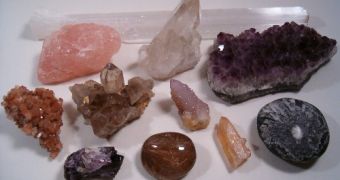Although the science of rocks is regarded as a dull, boring field, there's much more to it than just looking at an inert stone formation. Minerals are intimately linked to a planet's evolution and, moreover, to the emergence and development of life. In fact, this goes both ways, as minerals and life affect each other. In a previous article, we've shown how some specific diamonds could have helped life form, but minerals have also been influenced by the processes of life, such as the release of oxygen.
Regular analysis of rocks is mainly focused on their properties, but a new approach to mineral study has been recently proposed, namely, the one based on their relation with and impact on the evolution of the planet and of its biosphere. "Minerals have never been looked at in this historical context," explained Robert Hazen from the Carnegie Institution in Washington, D.C. to LiveScience. It is from this perspective that Hazen tried to present the several stages of evolution of minerals.
During the early years of the solar system, all of today's chemical elements were concentrated in about 12 minerals present in the pre-planetary primordial dust. As the solar system started shaping, the first stage of the evolutionary process of minerals occurred. This implied the "gravitational clumping" of particles into approximately 60 mineral species that were part of chondrite meteorites (the most ancient meteorites). In time, these too condensed into planetesimals, which had high pressure and temperature conditions that allowed for the formation of about 250 minerals during the second stage.
During the third stage, more clumping activity gathered planetesimals into planets, with volcanic activity and water presence leading to an increase in the number of minerals to about 500 types on Mars and Venus, and many more on Earth. The fourth stage indicated the emergence of the granites, which helped the minerals reach about 1,000 species, but the most prominent stage was definitely the fifth, which came with the plate tectonics (when pieces of Earth's crust were dipped into the molten mantle).
This raised the amount of mineral species to about 2,500. Since then, all the other minerals that appeared are due to the influence of life that appeared in the meanwhile, about 4 billion years back in time. The first sign of this was when microbes used minerals as energy sources, by subjecting them to chemically-transforming reactions. Over half of the elements of the periodic table are used in metabolic processes of lifeforms, explained Hazen.
The photosynthesis of plants (which releases oxygen), their decomposing bodies (accelerating clay minerals formation), and the organisms with shells and mineral skeletons (like corals, which created layered deposits of minerals such as calcite) had a great impact on the way minerals developed. "Mineral evolution is obviously different than Darwinian evolution — minerals don't mutate, reproduce or compete like living organisms. But we found both the variety and relative abundances of minerals have changed dramatically over more than 4.5 billion years of Earth's history," Hazen said.

 14 DAY TRIAL //
14 DAY TRIAL //